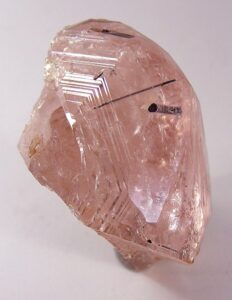
The Morganite gemstone is something you might be hearing about a lot nowadays. It has fast become a trend and for the people that have seen one in person, it is easy for them to understand why that’s the case. The Morganite is an exquisite violet-pink to light pink gemstone that has been a favorite among gemstone lovers for a few decades. It is an affordable yet resilient gem.
Morganite belongs to a family of minerals called the beryl and is often also referred to as Pink Beryl, Cesian Beryl, and Pink Emerald. Morganite is one of the rarer variations of the beryl mineral and is considered second in rarity only to the red bixbite. The gemstone is a mesmerizing stone that has a pinkish and almost salmon-colored hue, which sets it apart from the rest. This characteristic color for Morganite is because of the presence of manganese within the gem. Most Morganite gems are treated with heat that enhances the pinkish salmon hue even more.
Here is a look at everything that you need to know about Morganite.
Morganite Color
The color of Morganite varies within a range of pinkish colors. They can be found in colors ranging from pink, rose, and salmon to beach. The popularity of the Morganite gemstone in the market is because of the rose and pink tints that the stone has. While there is still a demand for salmon and peach hues, they are not as popular as their pinkish counterparts.
The gemstone is almost always put through treatment that enhances the pink color. The treatment isn’t something you can detect. Heat treatment effectively drives out the orange and yellow tinge that Morganite has, leaving a purer pink color. The resulting color is stable and does not fade.
Clarity
Much like other variations of the beryl mineral, Morganite usually is a very clear gem. It does not have a lot of visible inclusions. The lesser clear varieties of Morganite are often cut or carved out as cabochons.
Cuts
The Morganite gemstone has a very distinct color tone. The stronger color tones in Morganite are rare. Even if there are strong hues in the mineral, it has to be cut out from a fairly large stone to get the finest color from it. The orientation of the rough has to be considered carefully because of the pleochroism of this gemstone. It can be cut into all the standard shapes and sizes including unique designer cuts – this is one of the reasons why it is a popular gemstone for jewelry.
Origin of Morganite Gemstones
Morganite can be found in different parts of the world. The two most prominent producers of the Morganite are Madagascar and Brazil. There are also sources of the gemstone that can be found in Zimbabwe, Afghanistan, China, Mozambique, Russia, Namibia, China and even the United States.
Gemological Properties of Morganite
- Chemical Formula: Al2(Be3[Si6O18])
- Color: Pale Pink to Violet Pink, Salmon, Peach
- Crystal Structure: Hexagonal
- Hardness on Mohs Scale: 7.5 to 8
- Cleavage: Indistinct
- Fluorescence: Weak: Violet
- Luster: Vitreous
- Transparency: Transparent to opaque
Properties of Morganite Gemstone
For those who believe in the minerals’ emotional effects, Morganite is considered to be a stone that brings empathy, compassion, tolerance, self-control, and balance to the wearer. Through wearing the Morganite stone, a person can become capable of bringing stability to their life and control their emotions a lot better than before. The stone is also associated with easing the pain of people who have gone through separation from someone significant in their lives.
Morganite is a Heart Stone, which is also called the Stone of Divine Love. This stone brings love to the life of the wearer. The stone also has the potential to light the fire from an old flame and ignite the passion that one has in his or her love life.
One of the most wonderful things about the Morganite gemstone is that it is an aphrodisiac, which does not just allow the wearer to attract love but also to maintain it for the long term. It works by bringing in the caring and loving thoughts that help the two become more loving towards each other. It instills a greater feeling of well-being in both partners who wear the gemstone.
The beryl mineral is known to be a stone that physically heals people by relieving them of several conditions affecting the liver, glands, and eyes. Since Morganite is one of the variations of the Beryl mineral, it does not only have aphrodisiac properties, it also enhances the properties shown by other beryl gems. Morganite also helps to reorganize the cells, oxygenating them, and helps with breathing issues. It clears out lung blockages and asthma. It also has the power to cure emphysema.
Reasons Why You Can Use Morganite
Because there are so many properties that Morganite has, there are several uses that this stone can have for people. Some of these uses include:
- Wearing it relaxes the mind and reduces stress in your life.
- It challenges the wearer to become the best in everything that they do.
- It enhances a person’s level of confidence and instills a calming and peaceful feel in them, allowing for better handling of tough situations.
- It increases a sense of gratitude in the person wearing it.
- Wearing Morganite also makes a person grow mentally, emotionally, and spiritually.
- It increases the wearer’s wisdom.
- It transforms a person’s bad experiences into challenges that they would want to take on and overcome.
- It brings about a positive change in the wearer.

